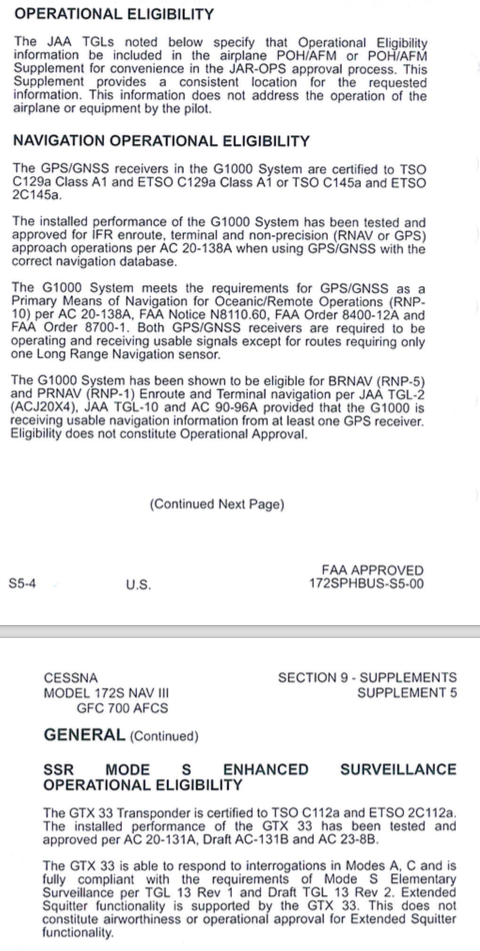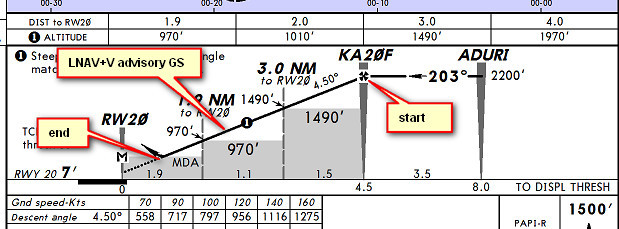Achimha,
You can remove and bring your GNS430W home. See Lonestar Commander. They can also be purchased at Spruce
Make sure it is the international version so it will work with your line voltage.
Hi all,
The topic has been up before in earlier threads but unfortunately I haven’t found an answer to my questions yet, so I thought I’d give it a try. My apologies if it’s been mentioned and I’ve missed it.
I fly a Cessna 172S G1000 (2008) and I’m trying to find out what the aircraft is actually eligible for in terms of GPS approaches. In the POH Section 9 it mentions that the “G1000 system has been tested and approved for IFR enroute, terminal and non-precision (RNAV or GPS) approach operations per AC 20-138A” (see picture below). The GPS/GNSS receivers are certified to TSO-C145a, which is mentioned in chapter 6.2 of the AMC 20-28 document (Airworthiness Approval and Operational Criteria related to Area Navigation for Global Navigation Satellite System approach operation to Localiser Performance with Vertical guidance minima using Satellite Based Augmentation System)
Since the text only mentions non-precision, should I interpret that as LNAV is OK but not LPV? LPV or APV is not mentioned at all. If that’s the case then I guess it’s “only” paperwork to get LPV approval?
All this regarding LPV/LNAV/PRNAV confuses the * out of me. Since G1000 is an integrated system with Cessna it seems to be harder to get approval than adding a Garmin 650 to an older aircraft, where PRNAV and LPV is included (at least for DA40).
Any help is much appreciated. (The personal requirements is another matter (and thread)).
Thanks in advance all!

Best regards,
Martin
In the US, it is straight forward. The G1000 with WAAS is certified to fly RNAV (GPS) approaches with LNAV, LNAV/VNAV, and LPV lines of minimums using WAAS for vertical guidance as long as the approach annunciation is adequate for the procedure at the time of the approach. So to fly an approach using the LPV minimums requires LPV be annunciated. The LPV annunciation also permits the pilot to fly the LNAV/VNAV or LNAV minimums if they are charted on the same procedure. The L/VNAV annunciation permits the pilot to use the LNAV/VNAV or LNAV minimums, if they are charted on the same procedure. An LNAV or LNAV+V annunciation only permits the LNAV line of minimums to be flown.
LPV and LNAV/VNAV procedures are not precision approaches. They are called APV (Approaches with Vertical guidance). In ICAO terminology they are APV with SBAS or RNP APR.
LNAV/VNAV approaches are APV designed for aircraft that have a Baro-VNAV approach guidance system. They have the same lateral guidance as a standard RNP 0.3 Approach and use GPS for the lateral. The TSO C145/146 SBAS systems are designed primarily for flying the LPV APV approach and have an angular lateral guidance equivalent to a Localizer. These systems are designed so they may also fly LNAV/VNAV approaches, even though they are not the primary reason for this equipment. In the US, there are very few procedures that have an LNAV/VNAV procedure that don’t also have an LPV on the same chart and with lower minimums. So with a WAAS system, in the US, one could ignore the LNAV/VNAV as it simply does not add any real capability and only complicates explaining them.
The US has two AC that are relevant for RNAV (GPS) approaches, AC 90-107 for LPV and LP approaches and AC-105 for LNAV and LNAV/VNAV approaches.
The 1st question is whether Martin’s year-2008 G1000 even does LPV – regardless of whether his POH authorises it.
Not every G1000 does LPV! Posts from here onwards confirm this (NCYankee knows his stuff). And the real good ones are here and onwards.
It could be an expensive upgrade.
@Jesse may know the European details.
The POH words “G1000 system has been tested and approved for IFR enroute, terminal and non-precision (RNAV or GPS) approach operations per AC 20-138A” just confirm the system does only NP approaches (GPS/LNAV or whatever is today’s name for it) i.e. lateral guidance only. Vertical guidance you have to do yourself; generally this is done by flying above the stepdown fixes, using the autopilot in the VS mode, with a VS value corresponding to the GS.
I have exactly the same capability with my KLN94, though I had to get the POH (the AFMS supplement) legalised. Most people wouldn’t bother with what the POH says but not having that AFMS exposes you to somebody who is out to get you, because the whole world can hear you asking for the approach on the radio 
PRNAV is a whole different can of worms. It appears to be the same thing as RNAV1. It requires aircraft approval (an AFMS) and crew approval. I have given up following it, but we have a long thread here to which posts were added more recently. Sweden appears to require the pilot to do a course of some sort. I vaguely recall the UK CAA (G-regs) has exempted private flights from the crew training/approval but this was a year ago I read that somewhere. A G1000 which doesn’t do LPV probably doesn’t come with a PRNAV AFMS either. You don’t need a “W box” (slang for an LPV capable GPS) to be PRNAV compliant; the original GNS430 can have it. It doesn’t seem to mean anything about actual capability of the GPS. The ability to get PRNAV approval hangs on whether the manufacturer issued a specific letter of compliance called AC90-96A or AC90-100A, which lists the G1000 AFAIK, but just because it is listed doesn’t do it; you still need that AFMS. On an N-reg it is almost impossible to get PRNAV approval retrospectively (due to non-cooperation from the NY IFU) and on an EASA-reg it is a Major mod. The number of European pilots who have done this process could be counted on your fingers, though a few more got in under the wire (one got his plane approved by burying the FAA under a mass of paperwork showing how brilliant he and his plane were and they gave it to him, and a few others got in on EASA-reg before EASA woke up and made it a Major mod). The only practical way to get PRNAV is to get it via an STC which leads to the GTN boxes, or the Avidyne IFD boxes (once Avidyne get their act together to be legal for Europe). If PRNAV interests you, I have some notes here (search on PRNAV) though they are possibly not up to date. I am not aware of any enroute airspace which requires PRNAV to just fly through it.
More confusion …
I thought there’s only these RNAV/GPS aporoaches
- LNAV
- LNAV+V
- LNAV/VNAV
- LPV
I also thought that LNAV/VNAV is done by GPS in our aircraft, and that LPV IS (!) a Precision Approach, no matter that LPV charts show MDAs and not DA’s. Or is it only technically a “precision” approach but not legally? Probably i got that wrong.
So what is APV? That one’s really new to me.
APV = approach with vertical guidance.
This is a term introduced by FAA because they found that a LPV approach would not fulfill all ICAO requirements for a precision approach.
From AIM, section 5-4-5, 7(b):
Approach with Vertical Guidance (APV). An instrument approach based on a navigation system that is not required to meet the precision approach standards of ICAO Annex 10 but provides course and glidepath deviation information. For example, Baro−VNAV, LDA with glidepath, LNAV/VNAV and LPV are APV approaches.
Practically speaking, light GA context, you have only 3 types of GPS approaches:
Not 100% sure I got the bits in brackets exactly right for today’s date!
All can be autopilot coupled.
For anoraks only:
LNAV+V should be available (i.e. in the Jepp database) at every airport for which GPS/LNAV has been designed, and the advisory glideslope is just a line drawn from the FAF to the MAP. Here is the Shoreham EGKA one

That advisory GS won’t be available if there is a stepdown fix (SDF) which pierces it, obviously; I am not sure if that is the case at any real airport (before the MAP, obviously!). See also here. But LNAV+V approaches have been removed from airports for which a different type of approach (baro VNAV; not applicable to light GA – ref) had been designed, on the basis that baro VNAV is similar to +V but is “better”. I am not sure what the latest on this is but Garmin were supposed to be fixing this issue.
+V is good for light GA because you can have it anywhere that Jepp chose to code it into the database. It needs no certification, no AFMS, no airport or CAA participation… In practical terms it is a “GPS ILS” but with the same MDA as the original GPS/LNAV approach.
Whether LPV is a “precision” approach is a play with words. You get a glideslope and you get assured obstacle clearance all the way to the runway, just like on an ILS, and if something walks like a duck and craps like a duck, it’s a duck…
But since LNAV/AVNAV approaches can use GPS instead of Baro we can use those too, right? Or are they not in the Jepp database? (Will get my W GPSs in a month, so can’t check)
Thanks for your replies, but I’m not sure if I’ve understood it fully yet.
First, what’s the difference between LNAV+V and LNAVVNAV? Have I understood it correct that these can be flown using SBAS (WAAS/EGNOS) or Baro-VNAV equipment?
Second, I remember trying out an GPS approach in VMC that had LPV on the plate. I loaded it just as an ILS but instead of getting the GS indication I got the GP (GlidePath), would that be shown for VNAV as well? The GFC700 AP flew it perfectly. How can I find out if it’s WAAS/EGNOS enabled?
Regarding the PRNAV can of worms, yes Sweden does require training so at the moment we are not allowed to fly the SID and STAR on GPS but an LPV approach is OK (if I’ve understood it correct). For now I focus on the GPS approaches :)
LNAV+V is an LNAV approach (no vertical guidance) with vertical advisory, while LNAV/VNAV and the other ones have “official” vertical guidance